2006 Hyundai Terracan belt
[x] Cancel search: beltPage 296 of 539
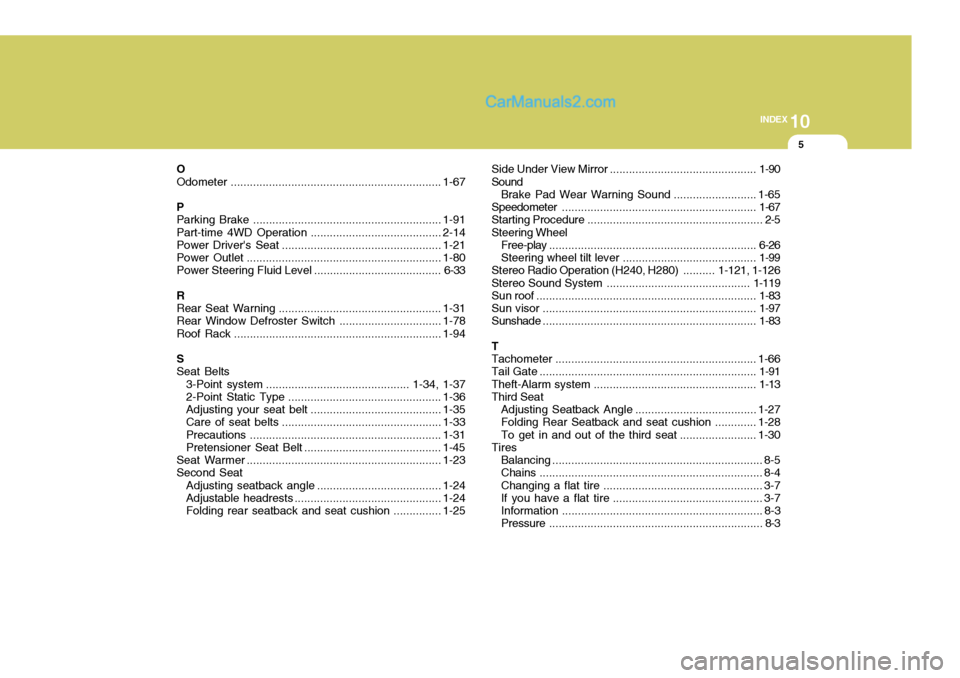
10
INDEX
5
O Odometer .................................................................. 1-67
P Parking Brake ........................................................... 1-91
Part-time 4WD Operation .............. ...........................2-14
Power Driver's Seat .................................................. 1-21
Power Outle t ............................................................. 1-80
Power Steering Fluid Level ........................................ 6-33
R Rear Seat W arning ................................................... 1-31
Rear Window Defroster Switch ................................ 1-78
Roof Rack ................................................................. 1-94
S Seat Belts 3-Point system ............................................. 1-34, 1-37
2-Point Static Type ................................................ 1-36
Adjusting your seat be lt .........................................1-35
Care of seat belts .................................................. 1-33
Precautions ............................................................ 1-31
Pretensioner Seat Belt ............... ............................ 1-45
Seat Warmer ............................................................. 1-23
Second Seat
Adjusting seatback angle ................. ...................... 1-24
Adjustable headrests . ............................................. 1-24
Folding rear seatback and seat cushion ...............1-25Side Under V
iew Mirror .............................................. 1-90
Sound Brake Pad Wear Warning Sound ..........................1-65
Speedometer ............................................................. 1-67
Starting Procedure ....................................................... 2-5
Steering Wheel Free-play ................................................................. 6-26
Steering wheel tilt lever .......................................... 1-99
Stereo Radio Operation (H240, H280) ..........1-121, 1-126
Stereo Sound System ............................................. 1-119
Sun r oof ..................................................................... 1-83
Sun visor ................................................................... 1-97
Sunshade ................................................................... 1-83
T Tachometer ............................................................... 1-66
Tail Gate .................................................................... 1-91
Theft-Alarm system ................................................... 1-13
Third Seat
Adjusting Seatback Angle ......................................1-27
Folding Rear Seatback and seat cushion .............1-28
To get in and out of the third seat ........................1-30
Tires
Balancing .................................................................. 8-5
Chains ...................................................................... 8-4
Changing a flat tire .................................................. 3-7
If you have a flat tire ............................................... 3-7
Information ............................................................... 8-3
Pressure ................................................................... 8-3
Page 308 of 539
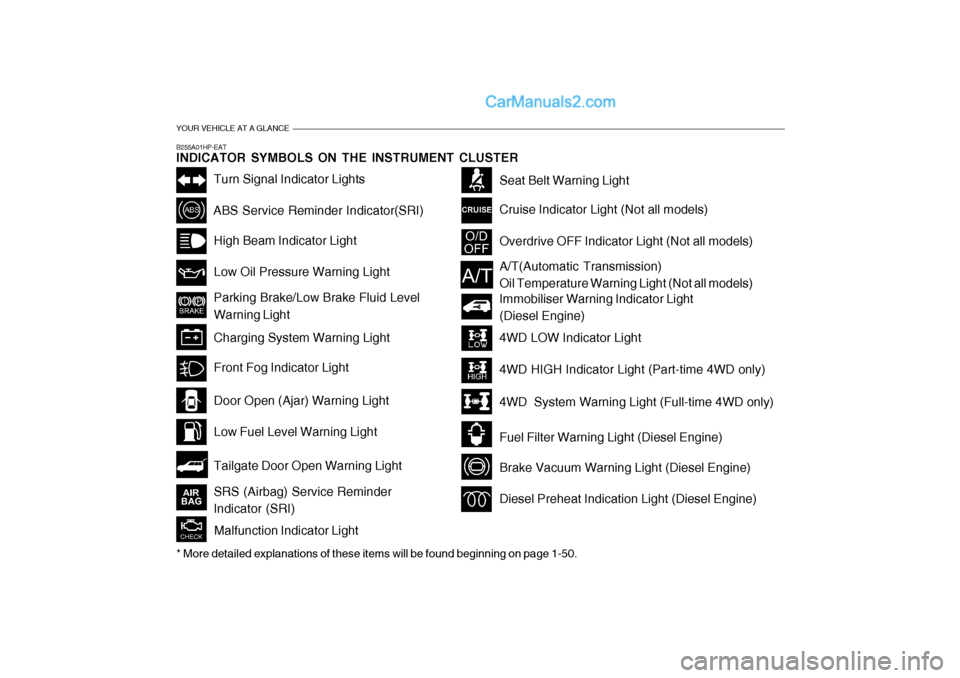
YOUR VEHICLE AT A GLANCE
B255A01HP-EAT INDICATOR SYMBOLS ON THE INSTRUMENT CLUSTER
Turn Signal Indicator Lights
ABS Service Reminder Indicator(SRI)High Beam Indicator Light Low Oil Pressure Warning Light Parking Brake/Low Brake Fluid Level Warning Light Charging System Warning Light
Tailgate Door Open Warning Light
Door Open (Ajar) Warning Light Low Fuel Level Warning Light
Front Fog Indicator Light
Overdrive OFF Indicator Light (Not all models)
Immobiliser Warning Indicator Light (Diesel Engine)
Seat Belt Warning Light Cruise Indicator Light (Not all models)
Malfunction Indicator Light
A/T(Automatic Transmission) Oil Temperature Warning Light (Not all models)
4WD LOW Indicator Light 4WD HIGH Indicator Light (Part-time 4WD only)
4WD System Warning Light (Full-time 4WD only)
Fuel Filter Warning Light (Diesel Engine)
Brake Vacuum Warning Light (Diesel Engine)
Diesel Preheat Indication Light (Diesel Engine)
* More detailed explanations of these items will be found beginning on page 1-50.SRS (Airbag) Service Reminder Indicator (SRI)
Page 309 of 539

Fuel Recommendations ............................................... 1-2
Running In Your Hyundai .............................................. 1-4
Immobiliser System ...................................................... 1-5
Door Locks ................................................................... 1-9Anti-theft Alarm System............................................... 1-11
Power Windows ........................................................... 1-14
Seats ........................................................................... 1-16
Seat Belts .................................................................... 1-25
Child Restraint System ................................................ 1-31
Supplemental Restraint (AIRBAG) System .................1-40
Instrument Cluster and Indicator Lights .......................1-46
Warning and Indicator Lights....................................... 1-50
Multi-Function Switch .................................................. 1-60
Windscreen Wiper/Washer Switch ..............................1-63
Sunroof ........................................................................ 1-70
Mirror ........................................................................... 1-75
Bonnet Release ........................................................... 1-83
Cruise Co ntrol.............................................................. 1-87
Heating and Cooling Control .......... ..............................1-90
Stereo Sound System ............................................... 1-106
Antenna ..................................................................... 1-108
CONTROLS AND EQUIPMENT
1
1
Page 311 of 539

1
CONTROLS AND EQUIPMENT
3
ZB010C1-E "Alternative fuels" Fuels which contain methanol or etha- nol must not be used. ZB010D1-E Operation in Foreign Countries Drivers of vehicles which are to be operated in foreign countries must satisfy themselves that:
o The vehicle meets all local regula- tions with respect to insurance, speci- fications etc..
o The correct types and grades of fuel
are available for satisfactory opera-tion of the vehicle.
ZB010F2-A FUELS FOR CLEANER AIR To help contribute to cleaner air, Hyundai recommends that you use fuels treated with detergent additives, which help to prevent deposit forma-tion in the engine. These fuels will help the engines run cleaner and increase the Emission Control System perfor-mance.BEFORE ENTERING THE VE- HICLE
YB020A1-E
o Ensure that all windows, mirrors
and lamps are clean.
o Check condition of all tyres.
o Ensure that no fluid leaks are evi-
dent.
o Ensure that the area around the
vehicle is clear before driving off.AFTER ENTERING THE VE- HICLE
YB020B1-E
o Ensure that all occupants fasten
and correctly adjust seat belts.
o Ensure that seat and head restraint
positions are adjusted for optimum safety, control and comfort.
o Adjust interior and exterior rearview
mirrors.
o Verify correct operation of lamps, horn and other electrical equipment.
o Ensure that warning lamps illumi- nate when ignition is turned on.
NOTE: Fluid levels such as engine oil, en- gine coolant, brake and windscreenwasher fluid should be checked daily or at each refuelling, whichever occurs sooner.
Page 325 of 539
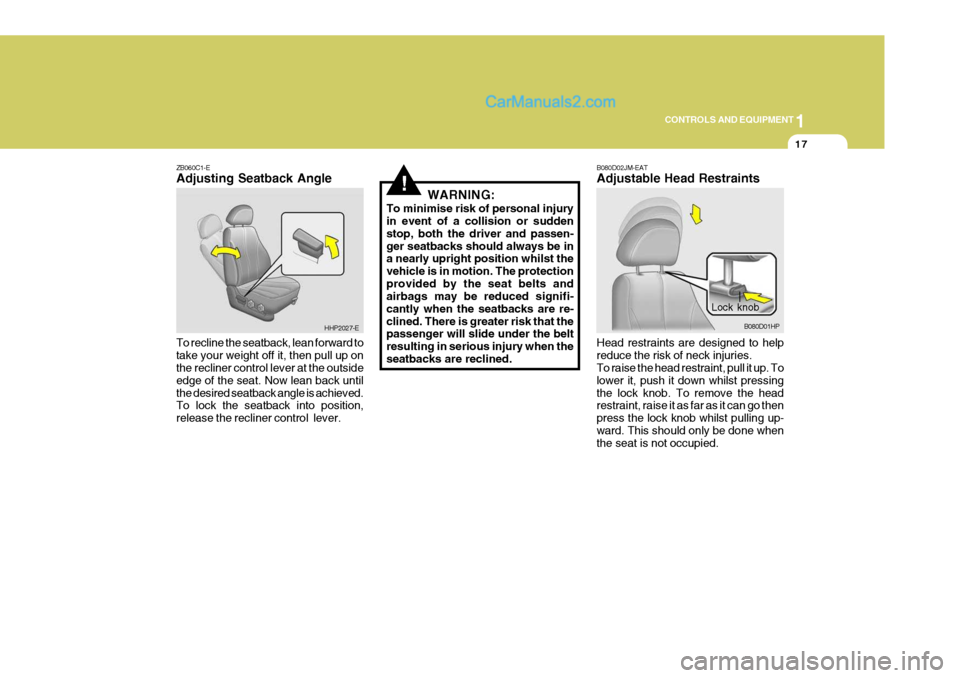
1
CONTROLS AND EQUIPMENT
17
!
ZB060C1-E Adjusting Seatback Angle To recline the seatback, lean forward to take your weight off it, then pull up on the recliner control lever at the outside edge of the seat. Now lean back untilthe desired seatback angle is achieved. To lock the seatback into position, release the recliner control lever. WARNING:
To minimise risk of personal injury in event of a collision or sudden stop, both the driver and passen-ger seatbacks should always be in a nearly upright position whilst the vehicle is in motion. The protectionprovided by the seat belts and airbags may be reduced signifi- cantly when the seatbacks are re-clined. There is greater risk that the passenger will slide under the belt resulting in serious injury when the seatbacks are reclined.
HHP2027-E
Lock knob
B080D01HP
B080D02JM-EAT Adjustable Head Restraints Head restraints are designed to help reduce the risk of neck injuries. To raise the head restraint, pull it up. To lower it, push it down whilst pressingthe lock knob. To remove the head restraint, raise it as far as it can go then press the lock knob whilst pulling up-ward. This should only be done when the seat is not occupied.
Page 328 of 539
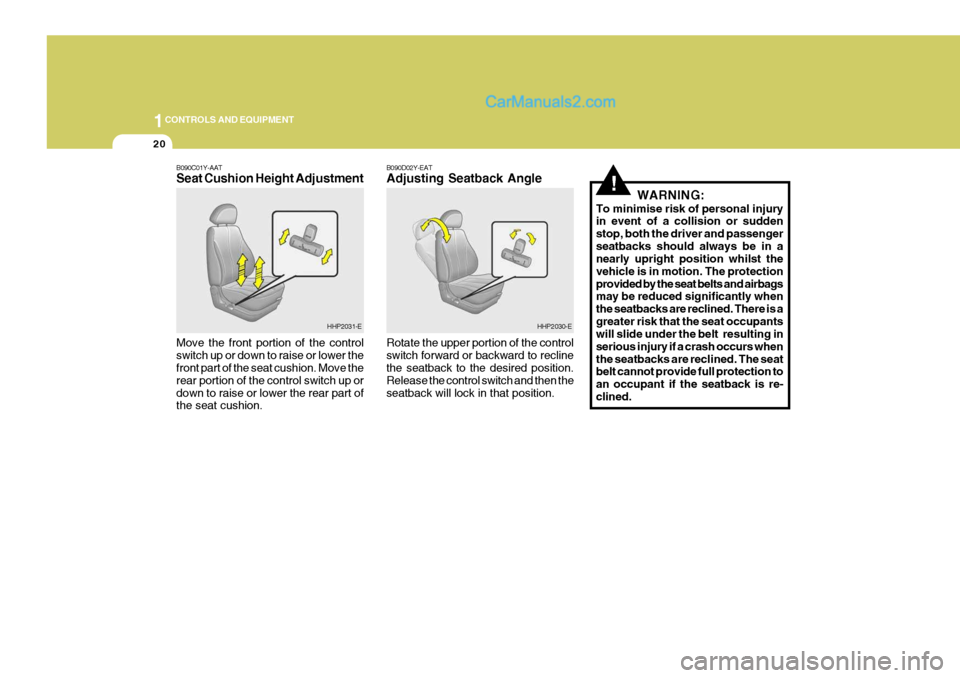
1CONTROLS AND EQUIPMENT
20
!
B090C01Y-AAT Seat Cushion Height Adjustment Move the front portion of the control switch up or down to raise or lower the front part of the seat cushion. Move the rear portion of the control switch up ordown to raise or lower the rear part of the seat cushion. B090D02Y-EAT Adjusting Seatback Angle Rotate the upper portion of the control switch forward or backward to recline the seatback to the desired position. Release the control switch and then theseatback will lock in that position.
WARNING:
To minimise risk of personal injury in event of a collision or sudden stop, both the driver and passengerseatbacks should always be in a nearly upright position whilst the vehicle is in motion. The protectionprovided by the seat belts and airbags may be reduced significantly when the seatbacks are reclined. There is agreater risk that the seat occupants will slide under the belt resulting in serious injury if a crash occurs whenthe seatbacks are reclined. The seat belt cannot provide full protection to an occupant if the seatback is re-clined.
HHP2031-EHHP2030-E
Page 331 of 539
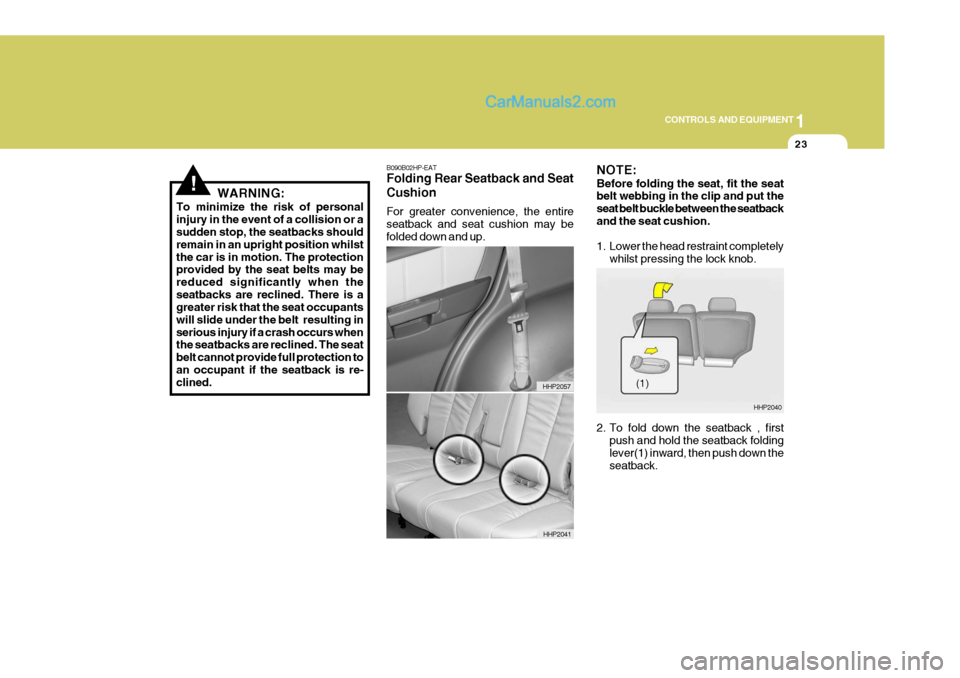
1
CONTROLS AND EQUIPMENT
23
!
B090B02HP-EAT Folding Rear Seatback and Seat Cushion For greater convenience, the entire seatback and seat cushion may befolded down and up.
HHP2041
HHP2057
WARNING:
To minimize the risk of personal injury in the event of a collision or a sudden stop, the seatbacks should remain in an upright position whilstthe car is in motion. The protection provided by the seat belts may be reduced significantly when theseatbacks are reclined. There is a greater risk that the seat occupants will slide under the belt resulting inserious injury if a crash occurs when the seatbacks are reclined. The seat belt cannot provide full protection to an occupant if the seatback is re- clined.
HHP2040
(1)
NOTE: Before folding the seat, fit the seat belt webbing in the clip and put the seat belt buckle between the seatbackand the seat cushion.
1. Lower the head restraint completely
whilst pressing the lock knob.
2. To fold down the seatback , first push and hold the seatback folding lever(1) inward, then push down the seatback.
Page 333 of 539
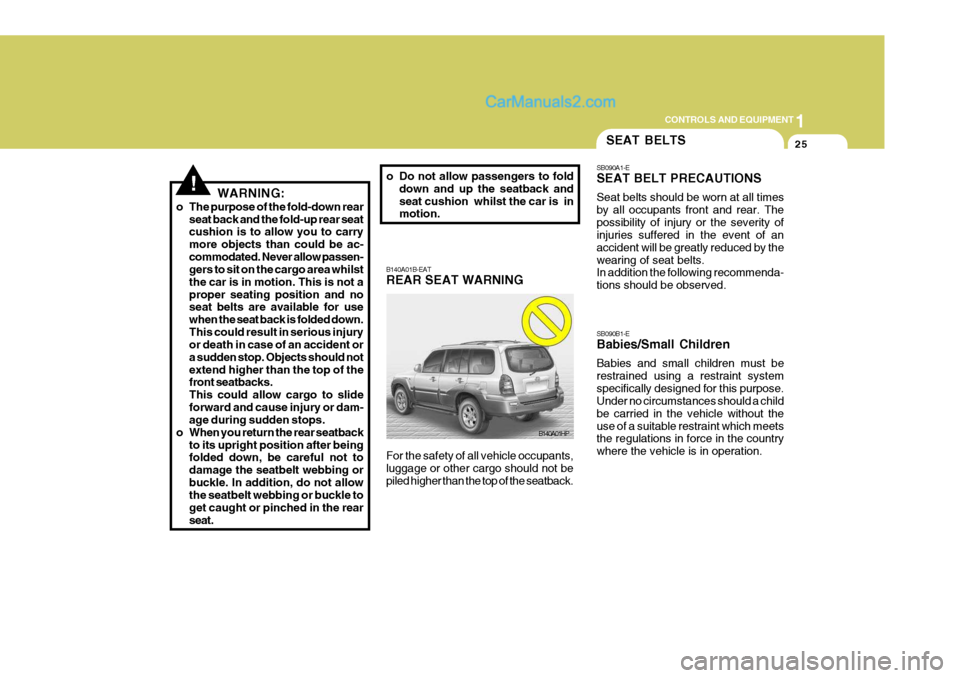
1
CONTROLS AND EQUIPMENT
25
!
B140A01B-EAT REAR SEAT WARNING For the safety of all vehicle occupants, luggage or other cargo should not be piled higher than the top of the seatback.
B140A01HP
WARNING:
o The purpose of the fold-down rear seat back and the fold-up rear seat cushion is to allow you to carry more objects than could be ac-commodated. Never allow passen- gers to sit on the cargo area whilst the car is in motion. This is not aproper seating position and no seat belts are available for use when the seat back is folded down.This could result in serious injury or death in case of an accident or a sudden stop. Objects should notextend higher than the top of the front seatbacks. This could allow cargo to slideforward and cause injury or dam- age during sudden stops.
o When you return the rear seatback
to its upright position after beingfolded down, be careful not to damage the seatbelt webbing orbuckle. In addition, do not allow the seatbelt webbing or buckle to get caught or pinched in the rearseat. o Do not allow passengers to fold
down and up the seatback andseat cushion whilst the car is in motion.
SB090B1-E Babies/Small Children Babies and small children must be restrained using a restraint systemspecifically designed for this purpose. Under no circumstances should a child be carried in the vehicle without theuse of a suitable restraint which meets the regulations in force in the country where the vehicle is in operation.
SEAT BELTS
SB090A1-E SEAT BELT PRECAUTIONS Seat belts should be worn at all times by all occupants front and rear. Thepossibility of injury or the severity of injuries suffered in the event of an accident will be greatly reduced by thewearing of seat belts. In addition the following recommenda- tions should be observed.